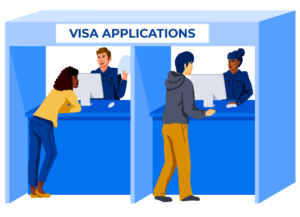In a past blog post, we explored what some of our Canadian partner schools are doing to support international students and help them thrive this fall and beyond. This week, we want to help you better understand your offer letter. We’ve also included four additional steps you’ll need to take after you receive it as you get ready to start your studies in Canada!

1. Understand Your Offer Letter
Congratulations on receiving your offer letter from a Canadian academic institution! You’ve hit the books and studied hard and should be proud of yourself.
Students applying to study in Canadian can receive two types of offers: An offer letter, sometimes called a pre-offer letter, or a letter of acceptance (LoA). One is conditional, and the other is unconditional. Let’s take a look at each one:
Offer or Pre-Offer Letter
Academic institutions can issue you an offer or pre-offer letter, meaning that a space is being saved for you in the program you applied to. However, to finalize your spot, you must meet conditions defined by the institution, like a required minimum grade average or submitting final transcripts. Then, if you’re still eligible after submitting the outstanding conditions or required documents, a letter of acceptance will be issued.
Important Note: You can’t use an offer or pre-offer letter to apply for a study permit.
Letter of Acceptance (LoA)
A letter of acceptance (LoA) is an official document from a college or university indicating you’ve been accepted to a program. A student who receives a letter of acceptance is not subject to any additional requirements in order to be accepted. (If you get one of these, you’re in.)
This document is recognized by the Canadian government and can be used to apply for a study permit.

2. Accept Your Offer
Next, you’ll want to accept your offer by completing your admission by the deadline set out by the college or university. How you accept your offer can vary depending on the school. Usually, you’ll accept through the institution’s online portal or simply by paying your tuition deposit.
Once you’ve accepted your offer, you’re one step closer to fulfilling your dream of studying abroad in Canada!

3. Apply for a Study Permit
Once you receive a letter of acceptance and have accepted your offer, you can apply for your study permit. A study permit allows international students to study at a designated learning institution (DLI) in Canada.
To apply for a study permit, you’ll need to have the following documents handy:
- A letter of acceptance
- A valid passport
- Proof you can financially support yourself, as well as any family members who intend to accompany you
You can apply for your study permit either online or by paper. The Canadian government recommends students apply for their study permits online, as online applications are:
- Received instantly and potentially processed more quickly
- Checked for completion prior to submission
Online applicants will also benefit from online status updates on their study permit applications. You can also quickly submit any additional supporting documentation if needed.
Student Direct Stream (For Reference Only – Program Closed in November 2024)
Until November 8, 2024, students like you may have been eligible for faster study permit processing through Canada’s Student Direct Stream (SDS). This program ran between 2018 and 2024, and allowed eligible international students from certain countries to speed up the processing of their Canadian study permit. Applicants provided more information up front, allowing officers to make a thorough assessment and final decision quickly.
Students from the following countries were eligible for SDS:
- Antigua and Barbuda
- Brazil
- China
- Colombia
- Costa Rica
- India
- Morocco
- Pakistan
- Peru
- Philippines
- Senegal
- Saint Vincent and the Grenadines
- Trinidad and Tobago
- Vietnam
Learn how Canadian schools are supporting international students this fall and beyond!

4. Enrol in Classes
Now the fun part—enrolling in classes!
Each college or university has its own enrolment schedule. This means you should review the calendar of important dates to know when you can start selecting your classes. You’ll also want to know which classes you’ll need to take, and when, to ensure that you graduate on time.
Starting Online
If it applies to you, check to see if you can start your study program online. You can do this even if you have not received a final decision on your study permit application. International students that are unable to study in person in Canada are still eligible for a post-graduation work permit (PGWP) until August 2023.
As long as you apply for a study permit before starting your program, the length of time you spend studying online will count towards a PGWP. This still applies even if your study permit application is rejected and you have to submit another one. However, you must be approved for a study permit (even if it takes a few tries) before becoming eligible for a PGWP.

5. Travel to Canada
If you meet the travel requirements and have your approved study permit, you may be ready to begin your travels. Be sure to check the Government of Canada’s website for more information.
Congratulations on receiving your offer letter. Follow the next steps outlined in this article, and you’ll be starting your studies before you know it. Happy travels—and happy studying!
Have more study abroad questions? Reach out to us today—ApplyBoard’s experienced team is here to help!



